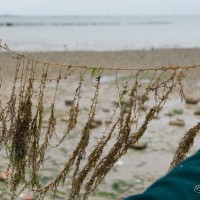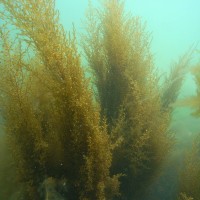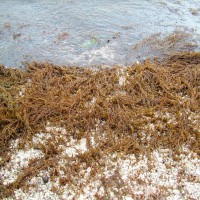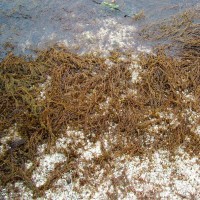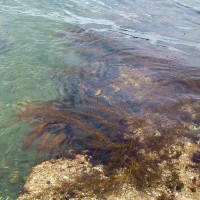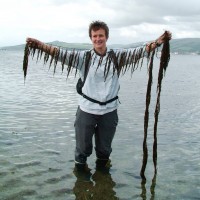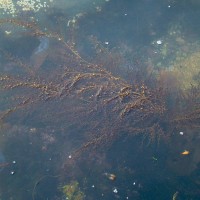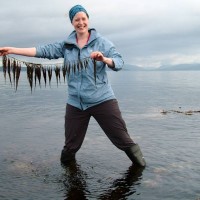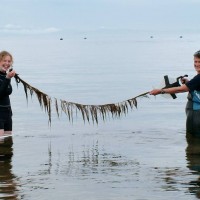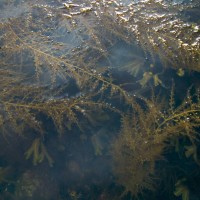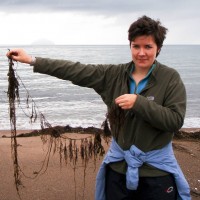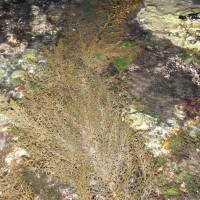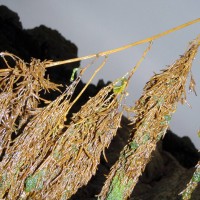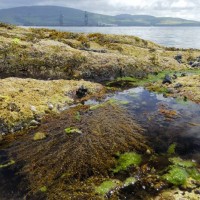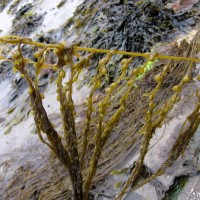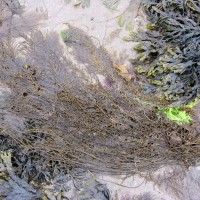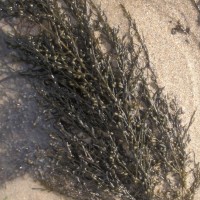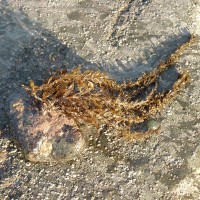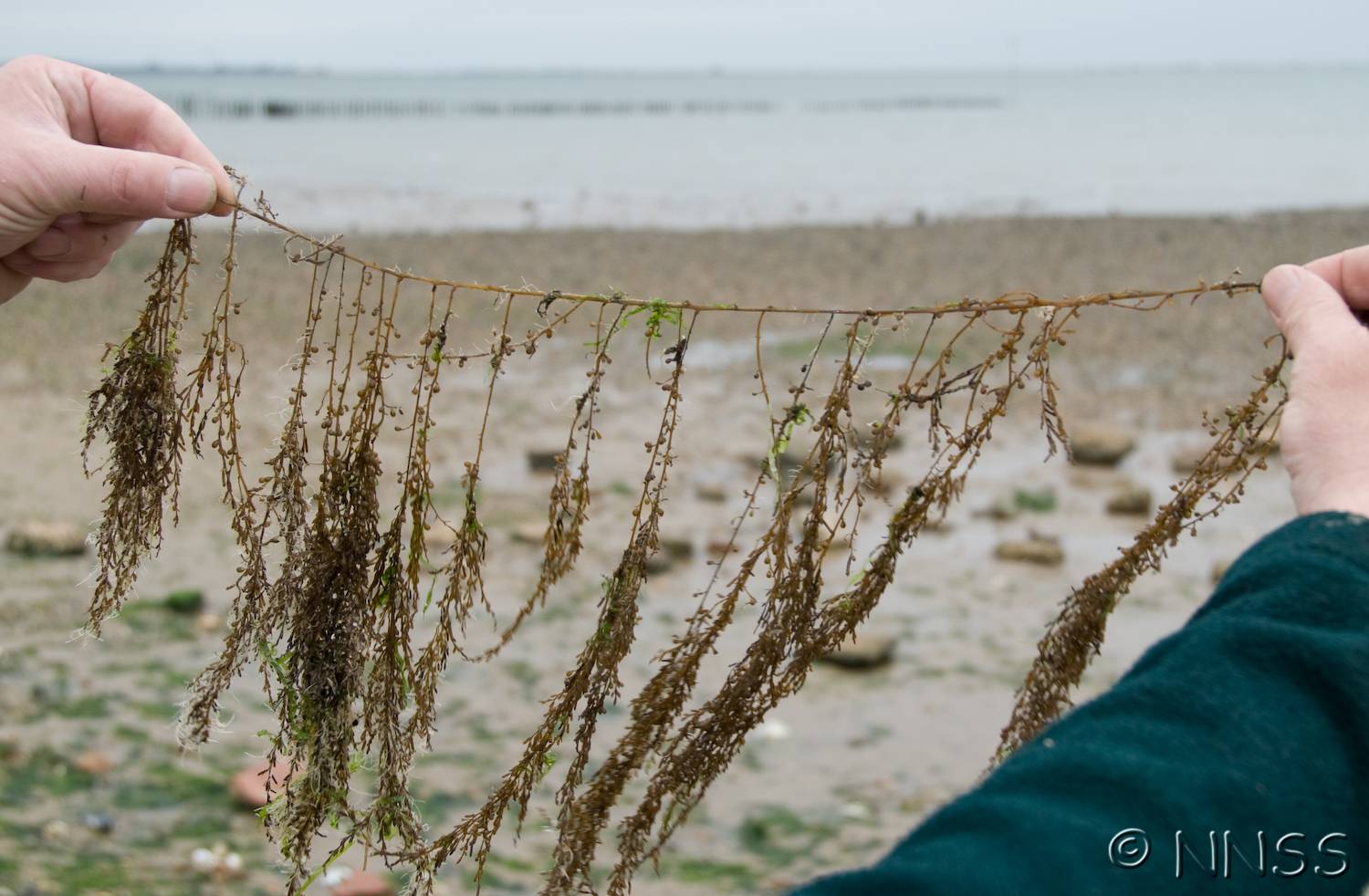
Wireweed - Sargassum muticum
Expand and collapse the sections below by clicking on the title or + / - icons.
Short description of Sargassum muticum, Wireweed
Highly distinctive large olive-brown seaweed (often over 1m long). The tough, wiry stem has regularly alternating branches with small, flattened oval blades and spherical gas bladders. Lateral branches hang like washing from a line when held out of the water.
Impact summary: Sargassum muticum, Wireweed
Wireweed competes with native seaweeds and seagrasses through rapid-growth, shading and abrasion. It is a nuisance in harbours and shallow waters where it is a hazard to boating (entanglement of propellers). It can dominate in rockpools altering the habitat.
Habitat summary: Sargassum muticum, Wireweed
Grows on hard surfaces in shallow waters and intertidally, particularly in rockpools. The species can also tolerate estuarine conditions. It can become detached and found floating in the sea.
Overview table
| Environment | Marine |
|---|---|
| Species status | Non-Native |
| Native range | Northwestern Pacific |
| Functional type | Algae (macroalgae) |
| Status in England | Non-Native |
| Status in Scotland | Non-Native |
| Status in Wales | Non-Native |
| Location of first record | Bembridge, Isle of Wight. |
| Date of first record | 1971 |
Origin
The native range of wireweed is the north-western Pacific shores of Japan, Russia, Korea and China.
First Record
Wireweed first appeared on the Isle of Wight in 1973 and has since spread along the south coast of England and into Wales, Ireland and Scotland.
Pathway and Method
Unintentional introduction with commercial oysters from the Canadian state of British Columbia or possibly Japan into France where it may then have reached GB by natural dispersal or as a fouling organism on boats and shellfish.
Species Status
Wireweed is established in many regions around the world and widespread on coasts around Europe. In 1944 wireweed was recorded in USA around the Strait of Georgia, British Columbia, reaching California in 1973 and it now occurs from south-east Alaska to Mexico.
Dispersal Mechanisms
Floating fragments of wireweed are transported long distances by ocean currents or by boats and on shellfish.
Reproduction
Wireweed reproduces sexually and via floating fragments. It produces gametes that fuse to form germlings which settle rapidly, usually near the parent. Detached fronds can continue to shed germlings as they drift.
Known Predators/Herbivores
Grazed on by sea urchins and some gastropod species. Germlings are also consumed by grazing species which could limit initial establishment.
Resistant Stages
None known.
Habitat Occupied in GB
Wireweed is most successful in areas sheltered from wave action, but occurs widely on the coast across a range of exposure. It grows intertidally and subtidally, particularly in rockpools and in shallow water, on hard surfaces in shallow coastal waters and in estuaries.
Native to Asian Pacific shores in Russia, Korea, Japan and China. It has invaded the Pacific coast of the USA and occurs from south-east Alaska to Mexico. Wireweed is now widely spread around the coast of continental Europe, from the Mediterranean to the Baltic. In GB it is distributed widely along the coasts of south and west England, Wales and west Scotland.
Environmental Impact
Wireweed out-competes native species because it is fast growing and reproduces within the first year of life by self fertilisation producing large numbers of offspring. Abundance of wireweed has been correlated with reduction in diversity of native seaweeds and other species such as sea oak. Dense stands reduce light, increase sedimentation and alter temperature in rockpools.
Health and Social Impact
Wireweed is considered a nuisance in harbours, beaches and shallow waters and can impair recreational activities such as swimming, diving, sailing and kayaking through entanglement.
Economic Impact
Wireweed fouls commercial oyster beds and fishing gear increasing costs associated with these activities. Dense stands may inhibit recreational activities reducing tourism and recreation related financial income in some places. Removal from man-made structures also contributes to economic costs.
Identification
Scottish Natural Heritage Fact Sheet
Biology, ecology, spread, vectors
Scottish Natural Heritage Fact Sheet
Sjøtun1. K., Sarah F. Eggereidel. S.F., Høisæter1. T. (2007) Grazer-controlled recruitment of the introduced Sargassum muticum (Phaeophyceae, Fucales) in northern Europe. Mar Ecol Prog Ser, 342, 127-138.
Management and impact
Critchley, A. T., W. F. Farnham, and S. L. Morrell. (1986) An account of the attempted control of an introduced marine alga Sargssum muticum in Southern England UK. Biological-Conservation, 35(4), 313-332.
General
www.marlin.ac.uk/habitatsbasicinfo.php?habitatid=309&code=2004
www.marlin.ac.uk/marine_aliens/species.asp?SpID=16
www.marlin.ac.uk/speciesinformation.php?speciesID=4296
Guiry, M.D. & Blunden, G. (eds) (1991) Seaweed Resources in Europe - Uses and Potential. John Wiley and Sons Ltd., Chichester.
Howson, C.M. & Picton, B.E. (ed.) (1997) The species directory of the marine fauna and flora of the British Isles and surrounding seas. Ulster Museum and The Marine Conservation Society, Belfast and Ross-on-Wye. Belfast: Ulster Museum. [Ulster Museum publication, no. 276.]
Lobban, C.S. & Harrison, P.J. (1997) Seaweed ecology and physiology. Cambridge University Press.
Lüning, K. (1990) Seaweeds. Their environment, biogeography and ecophysiology. New York: John Wiley & Sons
Norton, T.A. (ed.) (1985) Provisional Atlas of the Marine Algae of Britain and Ireland. Huntingdon: Biological Records Centre, Institute of Terrestrial Ecology.
Thomas, D.N. (2002) Seaweeds. The Natural History Museum, London.
https://www.cabi.org/isc/datasheet/108973
https://secure.fera.defra.gov.uk/nonnativespecies/downloadDocument.cfm?id=1749
Spotted this species?
Distribution map
View the Distribution map for Wireweed, Sargassum muticum from NBN Atlas
Risk assessment
Risk assessment for Sargassum muticum. See a full list of non-native species Risk assessments.
ID Sheet
ID Sheet for Sargassum muticum . See a full list of non-native species ID Sheets.
Legislation
This species is listed under Schedule 9 of the Wildlife and Countryside Act 1981. Read more about Non-native species legislation.

